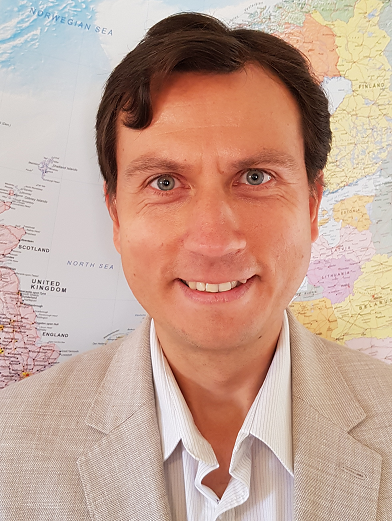We are looking for motivated MSc and PhD students and postdocs with strong C++ or Python skills to work on exciting projects in Geometric and Topological Data Science with real-life applications to Materials Science.
Please e-mail vitaliy(dot)kurlin(at)gmail(dot)com if you are interested and would like to join our Data Science group.
|
Potential projects in Geometric Data Science for PhD, MSc, and undergraduates: join us
- The projects are for students of the University of Liverpool from autumn 2023 but can be considered by external interns.
- A Data Science approach to protein folding. Proteins are key ingredients of all known life forms but understanding their functions and structures still requires scientific advances. The protein folding problem requires an explanation of how a primary (1-dimensional) sequence of amino acids folds into a tertiary (3-dimensional) structure. The algorithms such as AlphaFold2 and RosettaFold approximate local minima of discontinuous similarities that fail the metric axioms. Moreover, these black boxes use the Protein Data Bank (PDB) without filtering out the recently discovered duplicates, some of which need urgent corrections. This project will use the mathematically justified methods in the new area of Geometric Data Science to map geometric shapes of proteins. The ultimate aim is to develop an explainable solution to protein folding.
- A Data Science approach to materials design. Solid crystalline materials underpin many technological advances from solid-state batteries to safer crystalline drugs. Materials discovery still relies on trial-and-error because the basic questions of crystal equivalence and distances were not even properly stated. The ambiguity of conventional crystal representations was only recently resolved by the Crystal Isometry Principle, which continuously extends Mendeleev's table of chemical elements to a geographic-style map of all periodic crystals. After a crystal structure has been mathematically defined, the next step is to understand the structure-property hypothesis saying that any physical or chemical property of a crystal is determined by its structure. The project will analyse properties of simulated and real crystals including the world's largest set (Cambridge Structural Database) of experimental materials to predict hot spots for synthesising future materials.
- Differences between black boxes and the scientific method. The projects listed above aim to advance science, not to produce even more black-box tools that require weeks of supercomputer time and substantially contribute to carbon emissions making the climate crisis even worse. Self-driving cars are no longer featured at top conferences in Computer Vision such as CVPR because life-critical scenarios need scientifically justified methods instead of engineering heuristics. The so-called Large Language Models consume even more time and resources despite the artificial bot ChatGPT-4 cannot multiply 5-digit numbers, though this mechanical task was implemented already in 1642 by proper scientist Blaise Pascal.
- Expectations. The topics above are suitable for a student who dreams about a PhD with an impact. The project requires strong programming skills, preferably Python or C++. Communication skills will be needed to collaborate with other team members working on similar topics. The helpful module is COMP229 (Introduction to Data Science), which covers basic statistics, linear algebra, and computational geometry. Depending on progress, students can co-author joint publications.
- Publications based on past MSc or final year projects (all co-authored with former students):
MATCH 2022, DAMDID 2022, CaG 2020, VISAPP 2020, TopoInVis 2019, EMMCVPR 2017, JEI 2017, ISVC 2016, CCIS 2016. - How to apply for one of the projects above.
External candidates are welcome to follow the advice in the post how to join the research group. For internal candidates (final year and MSc students at the University of Liverpool), the first step is to e-mail Vitaliy Kurlin a CV or a brief description of your past programming projects. The second step will involve solving programming exercises on basic geometry and working with software libraries. After that I would be happy to meet for a 15-min discussion. Thank you.
Back to Top of this page | Back to Home page
Alumni of the Data Science group : postdocs, PhD graduates, and many more MSc/BSc students
- Former postdocs

September 2011 - August 2012 : Dr Alexey Chernov was mentored by Vitaliy Kurlin and funded by the EPSRC grant Persistent Topological Structures in Noisy Images (ref EP/I030328/1).
Joint paper : Image-A 2013.
Alexey now is a Senior Lecturer in Statistics at Brighton University, UK).
June 2021 - September 2023 : Dr Philip Smith was supervised by Vitaliy Kurlin (80%) and Igor Potapov, funded by the Leverhulme Research Centre for Functional Materials Design in the MIF.
PhD : Geometric and Topological Methods for Applications to Materials and Data Skeletonisation.
Joint papers : RCR 2024, ISVC 2022, PR 2021, SoCG 2021, ISVC 2019.
In 2021-2023, Phil had research and teaching positions at Liverpool, now a postdoc at Manchester. - 8 former PhD students (ordered by graduation date) who had me as the primary supervisor
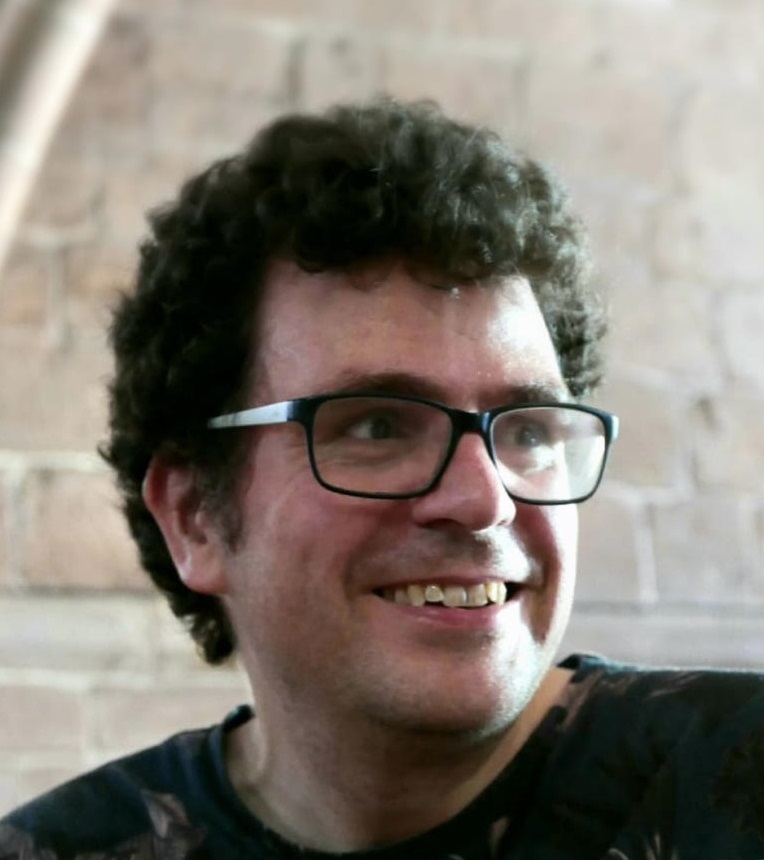
October 2019 - December 2023 (including one year 2021-2022 as a university teacher) Dr Matthew Bright was supervised by Vitaliy Kurlin and Andy Cooper.
PhD : Continuous Spaces of Low Dimensional Lattices.
Joint papers : Chirality 2023, ACA 2023, CMMP 2022, NumGrid 2021, CaG 2020.
Matt completed the first PhD in molecular biology (2005), then worked in data analytics industry, completed BSc (Open University) and MSc (Liverpool) in Mathematics, now a postdoc at Liverpool.
January 2019 - August 2023 Dr Thomas Welsch was supervised by Vitaliy Kurlin (60%) and Patrick Totzke, funded by the school of EEE&CS as the support for the EPSRC grant EP/R018472/1.
PhD : A framework for programme synthesis on conditional domains. Joint paper : GECCO 2020.
Thomas gained Computer Science degrees: BSc from Tennessee (US), then completed an excellent MSc thesis at the University of Liverpool on an image processing project important for Unilever.
October 2018 - January 2023 Dr Miloslav Torda was supervised by Yannis Goulermas (died suddenly in May 2022), Vitaliy Kurlin, Graeme Day (Southampton), funded by the LRC in the MIF.
PhD : Maximally dense crystallographic symmetry group packings for molecular crystal structure prediction acceleration. Joint papers : SISC 2023, PRE 2022.
Milo gained two 5-year degrees in Psychology and Mathematics (Probability) at Bratislava (Slovakia). In July 2023, Milo started a 3-year postdoctoral position in Andy Cooper's group in the MIF.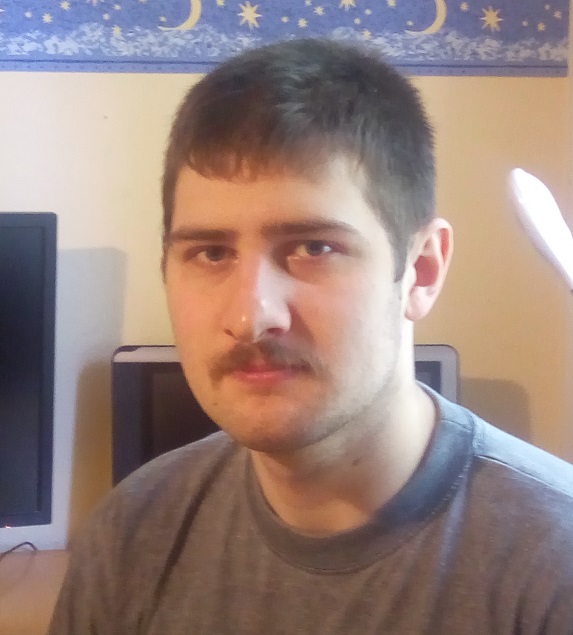
October 2017 - September 2022 Dr Yury Elkin was supervised by Vitaliy Kurlin (80%) and Marja Kankaanrinta (University of Helsinki, Finland), funded by the school of EEE&CS at Liverpool.
PhD : A new compressed cover tree for k-nearest neighbour search and the stable-under-noise mergegram of a point cloud. Joint papers : ICML 2023, TopoInVis 2022, Maths 2021, MFCS 2020, TopoInVis 2019. Yury is our postdoc funded by the EPSRC grant Inverse design of periodic crystals.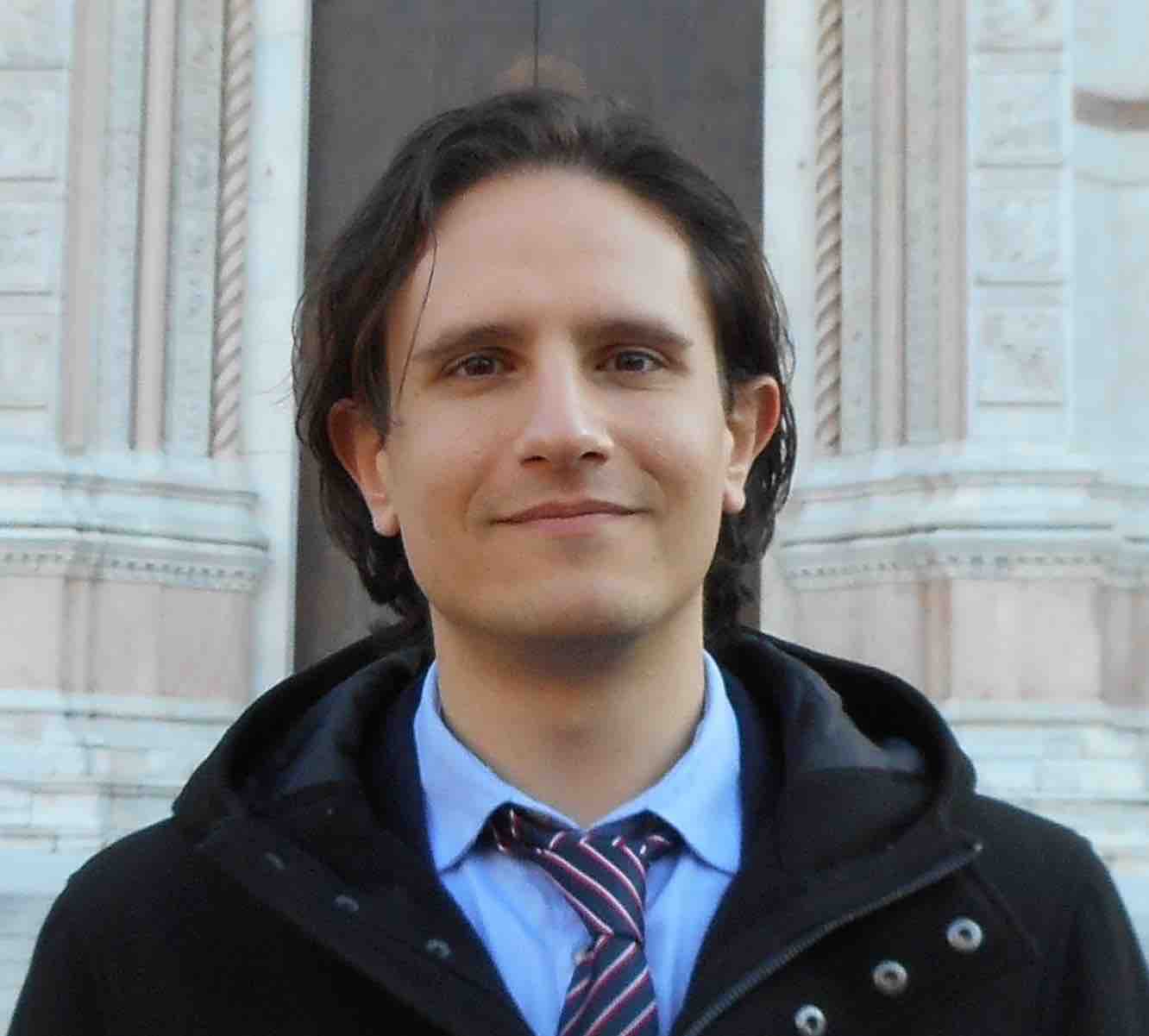
October 2018 - July 2022 Dr Marco Mosca was supervised by Vitaliy Kurlin (80%) and the MIF director Andy Cooper FRS, funded by the EEE&CS to develop an impact case with the CCDC.
PhD: Isometry Invariants of Crystal Structures Based on Voronoi Domains and Interatomic Distances.
Joint papers : MATCH 2022, DAMDID 2022, CRaT 2020.
In 2021, Marco started a software engineering job in the Wellcome Sanger Institute, Cambridge, UK.
October 2017 - June 2021 : Dr Philip Smith was supervised by Vitaliy Kurlin (80%) and Igor Potapov, funded by the Leverhulme Research Centre for Functional Materials Design in the MIF.
PhD : Geometric and Topological Methods for Applications to Materials and Data Skeletonisation.
In 2013-2017, Phil completed a 4-year Master of Mathematics degree at Durham, where we worked together on a summer project in Computer Vision funded by the London Mathematical Society.
April 2017 - January 2021 : Dr Grzegorz Muszynski was supervised by Vitaliy Kurlin (80%) and Michael Wehner (Lawrence Berkeley National lab, US). In August 2017, his Intel-funded project was announced in the university news and created the Intel Parallel Computing Center at Liverpool.
PhD : Pattern Recognition for Weather Phenomena in Climate Data. In 2020, Grzegorz had a Data Science job in the AI lab of the British Antarctic Survey in Cambridge, then moved to Oxford in 2021.
Joint papers : BDA 2022, ICPR 2021, PRL 2020, GMD 2019, JGRA 2019, CTIC 2019, GMD'18, CI'18.
October 2009 - June 2013 : Dr Marjan Safi-Samghabadi was supervised by Vitaliy Kurlin.
PhD : Collision-free motions of round robots on metric graphs.
Joint paper : ICRoM 2014
Marjan now works as a teacher and computer programmer in Tehran, Iran.
- 4 former PhD students (ordered by graduation date) who I helped as the secondary supervisor

October 2017 - June 2023 Dr Krasen Samardzhiev was supervised by Daniel Arribas-Bel, Vitaliy Kurlin (40%) and Alex Singleton, funded by the Data Analytics and Society CDT.
PhD : Characterising urban processes using new forms of data and analysis.
Krasen completed a BSc degree in Computer Science at Liverpool (UK), now works in software development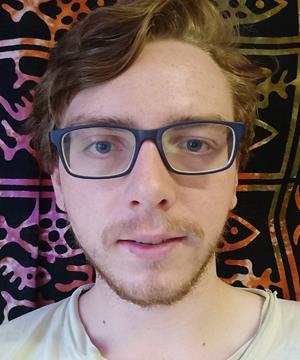
October 2018 - April 2023 Dr Cameron Hargreaves was supervised by Matthew Dyer and Vitaliy Kurlin (40%), funded by the SOLBAT project (a part the Industrial Strategy Challenge Fund).
PhD : Metrics for Materials Discovery.
Publications : npj Computational Materials 2023, Chemistry of Materials 2020.
Cameron completed BSc in Electrical Engineering and MSc in Computer Science at Liverpool. After completing the PhD, Cameron works as a postdoc at KU Leuven (Belgium).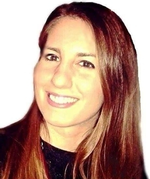
October 2018 - April 2022 Dr Katerina Vriza was supervised by Matthew Dyer and Vitaliy Kurlin (20%), funded by the CCDC and Leverhulme Research Centre at the MIF.
PhD : Accelerating Molecular Materials Discovery Following Data-Driven Approaches.
Publications : Digital Discovery 2022, Chemical Science 2021.
Katerina did a postdoc at the University of Leeds (UK), then moved to the Argonne national lab (US).
October 2017 - December 2021 : Dr Fraser Holloway was supervised by Laura Harkness-Brennan and Vitaliy Kurlin (40%), funded by the Big Data Science Centre for Doctoral Training.
PhD: The Development of Novel Pulse Shape Analysis Algorithms for AGATA (a gamma-ray detector). - Short term students in 2020-21 : Jiahui An (3rd year), Aditya Anandarajan (MSc), Phoebe Edwards (MSc), Gan Fang (3rd year), Xuhui Gong (3rd year), Thomas Greenway (MSc), Zhaoyu Han (3rd year), Sophie Hook (MSc), Yuelin Jiang (3rd year), Yang Li (3rd year), Jakob Ropers (3rd year), Tooba Sajid (Royce intern), Jack Simpson (MSc), Chi Fung Wan (MSc), Junzhe Wang (MSc), Yanbo Wang (self-funded intern), Haoran Xu (3rd year), Yang Yang (3rd year).
- Short-term project students in 2019-20: Jiahui An (2nd year), Cristian Badoi (4th year), Aaron Butterworth (4th year), Daniel Gardam (4th year), Yuzhao Chen (2nd year), Niko Theofilis (MSc), Chengzhe Li (3rd year), Yuanbang Liang (3rd year), Henan Liu (3rd year), Yulan Liu (3rd year), Jonathan McManus (summer project), Yifu Qian (3rd year), Musah Shaibu (MSc), Yuhao Wan (3rd year), Daniel Widdowson (MSc), Yuqing Yang (2nd year), Wenkai Zhang (3rd year).
- Short-term project students in 2018-19: Cristian Badoi (3rd year), Samuel Ball (4th year), Ruilin Han (3rd year), Yuhao Hua (3rd year), Di Liu (3rd year), Kristian Rowan (3rd year), Wenkai Zhang (2nd year), Yijia Zhao (3rd year).
- Short-term project students in 2017-18 (various periods from 8 weeks to 8 months): Abid Abdul (2nd year), Alex Bagnall (3rd year), Naohiko Ban (visiting PhD), Jacob Bracken (3rd year), Matthew Bright (MSc), Gemma Cook (MSc), Cameron Hargreaves (MSc), Di Liu (2nd year), Jingyi Lu (3rd year), Asim Munshi (graduate intern), Andrew Parry (3rd year), Antoine Rohmer (2nd year), Arshad Siddiqui (self-funded intern), Eris Tricker (graduate intern), Thomas Welsch (MSc).
- Summer students in 2017 : Graham Briggs (MSc), Jason Brewer (MSc), Sandra Garcia (MSc), Yuyao Wang (MSc), Zijian Li (MSc), Simon Hirst (EPSRC), Aviral Srivastava (self-funded intern), Falgun Patel (self-funded intern).
- Summer students in 2016 : David Torkington (MSc), Cheng Shen (MSc), Phil Smith (LMS), Aryaman Patel (intern on site).
- Mr Christopher Smithers : PhD supervised in 2015-2016 before moving to Liverpool, funded by the Leverhulme Trust.
Achievements of the past short-term student projects
- 2021 : Year 3 student Jacob Ropers completed a good final year project contributing to DAMDID 2022.
- 2020 : MSc student Dan Widdowson completed a great MSc thesis whose results contributed to MATCH 2022.
- 2018 : MSc student Matt Bright completed an excellent MSc thesis whose results are now published in CaG 2020.
- 2018 : intern Arshad Siddiqui worked in May-November with our group and published joint results in VISAPP 2020.
- 2018 : MSc student Thomas Welsch has solved a Computer Vision problem for Unilever, which co-funded his PhD.
- 2016 : Year 4 student Donald Harvey has completed the brilliant project Coarse-to-fine superpixel segmentation with a fast adaptive energy-based initialisation leading to the joint paper Superpixels Optimized by Color and Shape.
- 2016 : Year 4 student Jeremy Forsythe has completed the excellent project Convex Constrained Meshes: a new method to generate resolution-independent superpixels leading to the joint paper with Microsoft, see the journal version.
- 2011 : The projects of Mr Caspar De Haes (Map Colouring) and Mr Chris Palmer (Topological Robotics) were ranked the 2nd and 4th best year 4 projects in the department.
- MSc dissertations (3 months in the summer, last updated in 2020):
- Daniel Widdowson : Consideration of a new similarity measure for periodic sets (2020)
- Nikolaos Mariano Theofilis Sobrino : On Knot Theory in Python (2020)
- Musah Shaibu : A classification of periodic knots and linked networks (2020)
- Cameron Hargreaves : machine learning techniques for similarity of crystals (2018)
- Matthew Bright : A new combinatorial description of 2-periodic structures (2018)
- Thomas Welsch : Helping a robot to see a correctly placed piece of cloth (2018)
- Gemma Cook : Visualising shapes of high-dimensional datasets (2018)
- Graham Briggs : Exploratory geometric data analysis of crystals (2017)
- Jason Brewer : Creating a geospatial macro level feature database (2017)
- Sandra Garcia : Creating a geospatial macro level feature database (2017)
- Yuyao Wang : Automatic data analysis for atomistic simulations (2017)
- Cheng Shen : Data skeletonization via alpha-Reeb graphs (2016)
- David Torkington : Testing the Mapper skeletonisation algorithm (2016)
- Christopher Smithers : A linear time algorithm for embedding knotted graphs in 3 pages (2015)
- Marjan Safi-Samghabadi : Configuration spaces of graphs (2009)
- Suad Al-khmas : Virtual knots and knotted graphs (2008)
- Topological Data Analysis : final year projects
- Christopher Parkinson: Klein bottle model for a cloud of small patches from colour images (2016, year 4)
- Lewin Strauss: The skeletonisation problem in high dimensions (2016, year 4)
- Topological Robotics : final year projects
- Sam Bullen: Topological Complexity of Robot Motion Planning (2013, year 4)
- Alison Champernowne: Straightening a Robot Arm in the Plane (2013, year 4)
- Nathan Edwards: Euler Characteristic of Configuration Spaces (2013, year 4)
- Chris Guard: Locked Polygonal Linkages in 3-dimensional Space (2013, year 4)
- Martin Smith: Homotopy Types of Configuration Spaces of Graphs (2012, year 4)
- Emily Weir: Connectivity Algorithms for Configuration Spaces (2012, year 4)
- Chris Walker: Topological Complexity of Configuration Spaces (2011, year 4).
- Map Colouring : final year projects
- Katriina Nichols (2010, year 4)
- Camilla Banks (2009, year 3).
Back to Top of this page | Back to Home page
Seminar of the group in Data Science theory and applications
In March 2022 - September 2023, all seminars were joint with MIF++ almost weekly due to the world wide interest. From 9th February 2024, the DSTA group seminar runs on Fridays at 12.00 UK time joint with Data Science PhD training.
Past seminars in the reverse chronological order :
PhD training 2023-2024 |
MIF++ 2023 |
MIF++ 2022 |
2021-22 |
2020-21 |
2019-20 |
2018-19 |
2017-18
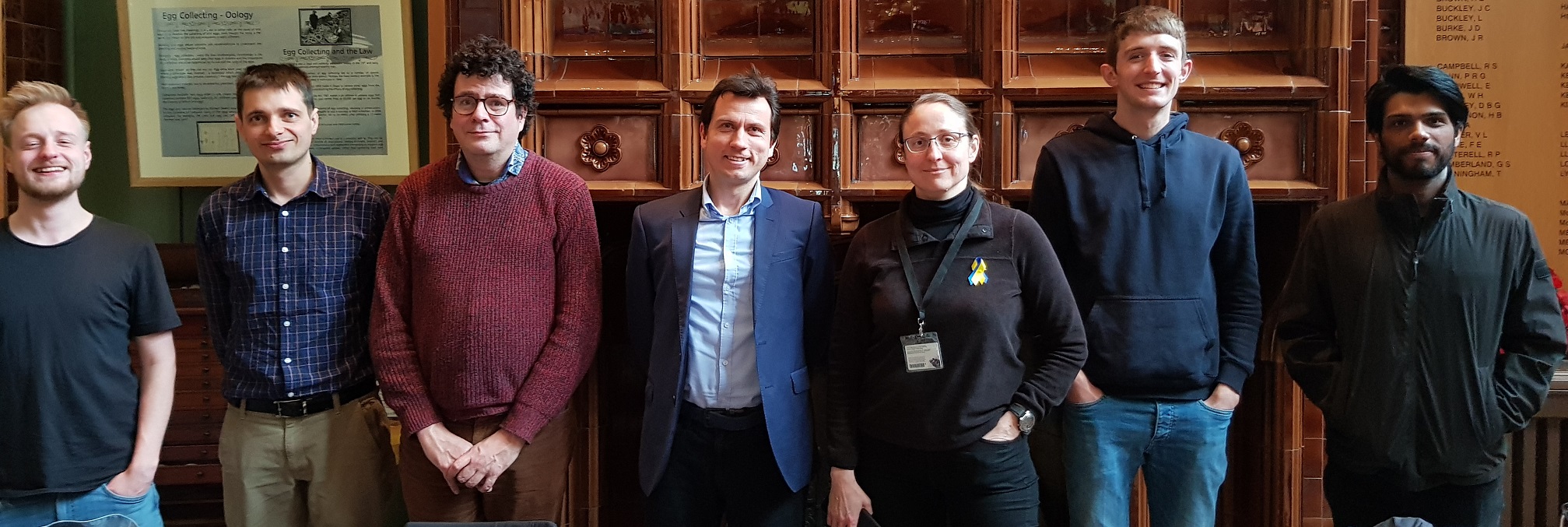
March 2023 : Dan Widdowson, Viktor Zamaraev, Matt Bright, Vitaliy, Olga Anosova, Will Jeffcott, Jonathan Balasingham
Group seminars in the academic year 2021-2022 (24 talks)
- 27 June 2022 (11 UK time). Dan Widdowson. Detection of near-duplicate crystals in the Cambridge Structural Database.
- 27 June 2022 (10 UK time). Jonathan Balasingham. AI-Based Exploration of Crystal Spaces to Accelerate Drug Discovery.
- 9 June 2022 (15-16 UK time). Matt Bright. Introduction to the research problems for periodic lattices and crystals.
- 18 March 2022. You Wu. Correlation between atoms’ chemical types and their k nearest neighbour distances.
- 11 March 2022 (joint with MIF++). Vitaliy Kurlin. Continuous metrics and chiralities of 2-dimensional lattices.
- 4 March 2022 (joint with MIF++). James Darby. Compressing local atomic neighbourhood descriptors.
- 3 March 2022. Adam Coxson. Introduction to the fundamentals of neural networks.
- 18 and 25 February 2022. Attending the TDA workshop and seminar at Oxford.
- 11 February 2022. Phil Smith. Families of point sets with identical 1D persistence.
- 4 February 2022. Adam Coxson. Using electronic structure descriptors to calculate the 1st excited state energies.
- 28 January 2022 (joint with MIF++). Vitaliy Kurlin. Geographic-style maps of crystal lattices.
- 21 January 2022. Adam Coxson. Physics Informed Machine Learning and Residual Modelling.
- 14 January 2022 (joint with MIF++). Michael White (Manchester). Digital Fingerprinting of Microstructures.
- Christmas group dinner (left to right): Caroline, Jonathan, Danny, Katerina, Phil, Olga, Vitaliy, Will, Matt.

- 10 December 2021 (joint with MIF++). Vitaliy Kurlin. Visual maps of the isometry space of 3-dimensional lattices.
- 3 December 2021. Katerina Vriza. Strategies for designing organic-based superconductors.
- 26 November 2021 (joint with the MIF++ seminar). Andreas Alpers. Tomographic Imaging of Crystalline Structures.
- 19 November 2021 (joint with the Oxford TDA workshop). Dan Widdowson. Mathematical Data Science for crystals.
- 12 November 2021 (joint with MIF++). Vitaliy Kurlin. Continuous metrics on isometry classes of 2-dimensional lattices.
- 5 November 2021. Muizdeen Raji. ML uncovers correlations of gene expression in a proliferative CLL cell subpopulation.
- 29 October 2021. Steff Farley. Quantitative Data Integration with Computational Models of Dewetting Processes.
- 22 October 2021. Milo Torda. Entropic trust region for densest crystallographic symmetry group packings.
- 15 October 2021 (joint with MIF++). Vitaliy Kurlin. Complete isometry invariants of lattices in dimensions 2 and 3.
- 8 October 2021. Vitaliy Kurlin. Introducton to Periodic Geometry and crystal classifications for new students.
- 1 October 2021. Yury Elkin. Cover trees for k-nearest neighbour search in a metric space (part 2).
- 24 September 2021. Yury Elkin. Cover trees for k-nearest neighbour search in a metric space (part 1).
- September 2021 : group walk to Hilbre island, which joins the coast at low tide. The names below are from left to right.


First : Phil, Danny, Vitaliy, Olga, Adam, Matt, Alessandro. Second : Adam, Matt, Vitaliy, Olga, Phil, Danny, Alessandro.
Back to All seminars | Back to Top of this page | Back to Home page
Group seminars in the academic year 2020-2021 (37 talks)
- 9 July 2021 (joint with MIF++). Dan Widdowson. Invariant-based visualisation of large crystal datasets.
- 2 July 2021. Jonathan McManus (Teddy). An algorithm to compute a Periodic Minimum Spanning Graph.
- June 2021 : group walk in Sefton park. The names below are from left to right (a nearly reversed order is accidental :-).


First : Teddy, Katerina, Matt, Phil, Hannah, Olga, Vitaliy. Second : Olga, Vitaliy, Hannah, Phil, Matt, Katerina, Teddy. - 25 June 2021. Jonathan McManus (Teddy). Periodic Minimum Spanning Graphs of periodic point sets.
- 18 June 2021.
Hugh Morton.
An introduction to the Alexander Data to classify textiles up to periodic isotopy.
(joint with the Oxford TDA meeting) Matt Bright. Isometry invariant-based formula for the linking number. - 11 June 2021. Dan Widdowson. Tutorial on how to read crystal data with Python libraries.
- 4 June 2021. Vitaliy Kurlin. Introducton to the group research for new MSc students.
- 21 May 2021. Dan Widdowson. Pointwise Distance Distributions of periodic point sets.
- 14 May 2021. Matt Bright. Conway's approach to classify lattices in dimensions two and three.
- 7 May 2021. Gan Fang and Jakob Ropers. Predicting the energy of a solid crystal from its isometry invariants.
- 30 April 2021. Krasen Samardzhiev. Dynamics and emergence of megaregional structures in US employment data.
- 23 April 2021. Jonathan McManus (Teddy). Implementing isosets for a comparison of periodic point sets.
- 16 April 2021. Jonathan McManus (Teddy). Introduction to invariant isosets and Minimum Quotient Graphs.
- 7 April 2021. Matt Bright. Introduction to Periodic Topology for textiles and crystal structures.
- 31 March 2021. Milo Torda. Geometry of the n-torus stochastic trust region method for materials discovery.
- 26 March 2021 (joint with the MIF++ seminar). Phil Smith. The density fingerprint of a periodic point set.
- 12 March 2021. Marco Mosca. Voronoi-based invariants for clustering datasets of periodic crystal structures.
- 5 March 2021. Dan Widdowson. TMap: visualising big, high-dimensional data with minimum spanning trees.
- 26 February 2021. Matt Bright. The Metric Quotient Graph - A Graph Invariant for Periodic Point Clouds.
- 19 February 2021. Fraser Holloway. The Development of Novel Pulse Shape Analysis Algorithms for AGATA.
- 12 February 2021 (joint with the Oxford seminar). Phil Smith. Density functions of periodic point sets.
- 5 February 2021. Viktor Zamaraev. On forbidden induced subgraphs for unit disk graphs.
- 29 January 2021. Marjan Safi-Samghabadi. How to automate systems [in industry].
- 22 January 2021. Milo Torda. Densest plane group packings of regular polygons.
- 15 January 2021. Grzegorz Muszynski. PhD viva practice 2: Pattern Recognition for Weather Phenomena in Climate Data.
- 8 January 2021. Grzegorz Muszynski. PhD viva practice 1: Pattern Recognition for Weather Phenomena in Climate Data.
- December 2020 : despite the ongoing pandemic, our group celebrated Christmas online, here are some individual photos.



 From left to right: Phil, Vitaliy, Marco, Marjan.
From left to right: Phil, Vitaliy, Marco, Marjan.
- 11 December 2020. Dan Widdowson. Asymptotic behaviour of the Average Minimum Distances.
- 4 December 2020. Aidan Watmuff. Using k-modes clustering to identify different types of cyclists.
- 20 November 2020. Matt Bright. The invariant-based formula for the linking number of line segments.
- 13 November 2020. Muizdeen Raji. Machine learning for mass cytometry data of chronic lymphocytic leukemia.
- 11 November 2020 (joint with the ACTO group). 15-min introductions to Periodic Geometry by Vitaliy, Marco, Phil.
- 30 October 2020. Matt Bright. SOAP (Smooth Overlap of Atomic Positions) and other local descriptors of crystals.
- 23 October 2020. Informal discussions of potential final year projects in five subgroups led by senior PhD students.
- 16 October 2020. Vitaliy Kurlin. An introduction to research problems on crystals for new final year project students.
- 9 October 2020.
Katerina Vriza.
One class classification as a practical approach for accelerating co-crystal discovery.
(plus two more short practice talks by the new PhD students Daniel Widdowson and Jonathan McManus). - 2 October 2020. Cameron Hargreaves. Computation of the Wasserstein metric (Earth Mover's Distance).
- 29 September 2020. Yury Elkin. The mergegram of a clustering dendrogram for point clouds.
- 18 September 2020. Marco Mosca. A discussion of distance-based invariants of crystals.
Back to All seminars | Back to Top of this page | Back to Home page
Group seminars in the academic year 2019-2020 (37 talks)
- 17 July 2020. Milo Torda. Space group optimization algorithm based on information geometry.
- 16 July 2020. Yury Elkin. The mergegram of a clustering dendrogram and its stability.
- 10 July 2020. Marco Mosca. Average Minimum Distances are stable isometry invariants of crystals.
- 3 July 2020. Katerina Vriza. Machine Learning in Materials Science. Case study: molecular co-crystals.
- 19 June 2020. Marco Mosca. Voronoi-based similarity distances between arbitrary crystal lattices.
- 12 June 2020. Grzegorz Muszynski. Topological Data Analysis for recognizing Atmospheric River patterns.
- 5 June 2020. Grzegorz Muszynski. Atmospheric Blocking Pattern Recognition in Global Climate Simulation Data.
- 29 May 2020. Vitaliy Kurlin. An introduction to research problems on crystals for new and future students.
- 22 May 2020. Thomas Welsch. Synthesis through Unification Genetic Programming.
- 15 May 2020. Matt Bright. Encoding and topological computation on textile structures.
- 30 April 2020. Phil Smith. Stability of density functions of periodic crystals.
- 24 April 2020. Phil Smith. Stability of Voronoi diagrams under perturbations.
- 27 March 2020. Vitaliy Kurlin. A continuous approach to a crystal classification.
- 20 March 2020. Vitaliy Kurlin and Marco Mosca. Reduced cells of crystals.
- 6 March 2020. Three talks at different times: 10-12, 13-14 and 14-15.
Yury Elkin (10-12). Machine learning techniques in Topological Data Analysis.
Muizdeen Raji (13-14). Statistical analysis of microRNA and messenger RNA profiling.
Cristian Badoi (14-15). Samply: predicting formulae of chemical compounds. - 28 February 2020. Thomas Welsch. Evolutionary computation for program synthesis.
- 21 February 2020. Phil Smith. Voronoi domains and Brillouin zones of periodic point sets.
- 14 February 2020. Matt Bright. Classifying fabric structures: an application of knot theory.
- 7 February 2020. Marco Mosca. Voronoi-based similarity distances between crystal lattices.
- 31 January 2020. Cameron Hargreaves. The dimensionality reduction by UMAP and applications to solid state discovery.
- 17 January 2020. Muizdeen Raji. Machine learning for cell clustering and predictions from mass cytometry data.
- 10 January 2020. Phil Smith. Packing functions are new isometry invariants of periodic crystals.
- December 2019 : we have had great Christmas dinner with all available students, many thanks to Katerina for organising!
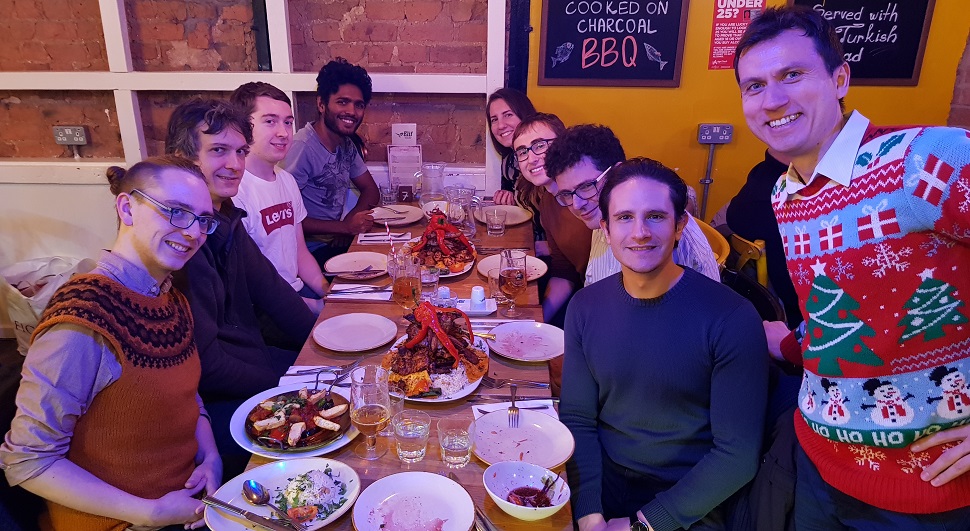
Group dinner in December 2019 from left to right: Cameron, Milo, Sam, Shiyam, Katerina, Phil, Matt, Marco, Vitaliy. - 13 December 2019. Fraser Holloway. Machine Learning and Topological Data Analysis for Pulse Shape Analysis.
- 6 December 2019. Katerina Vriza. Machine learning methods for predicting co-crystals.
- 29 November 2019. Cristian Badoi, Aaron Butterworth, Daniel Gardam. Sampling a space of chemicals.
- 22 November 2019. Thomas Welsch. An introduction to program synthesis.
- 15 November 2019. Yury Elkin. Stability of hierarchical clustering algorithms.
- 8 November 2019. Cameron Hargreaves. The Minimal Cost Flow atomic similarity.
- 1 November 2019. Matt Bright. Realisability of Gauss paragraphs for 2-periodic links.
- October 2019 : the photo of the DSTA group : Cameron Hargreaves, Matt Bright, Vitaliy Kurlin, Georg Osang (visitor from IST Austria), Philip Smith, Cristian Badoi, Yury Elkin, Katerina Vriza, Miloslav Torda, Marco Mosca, Thomas Welsch.
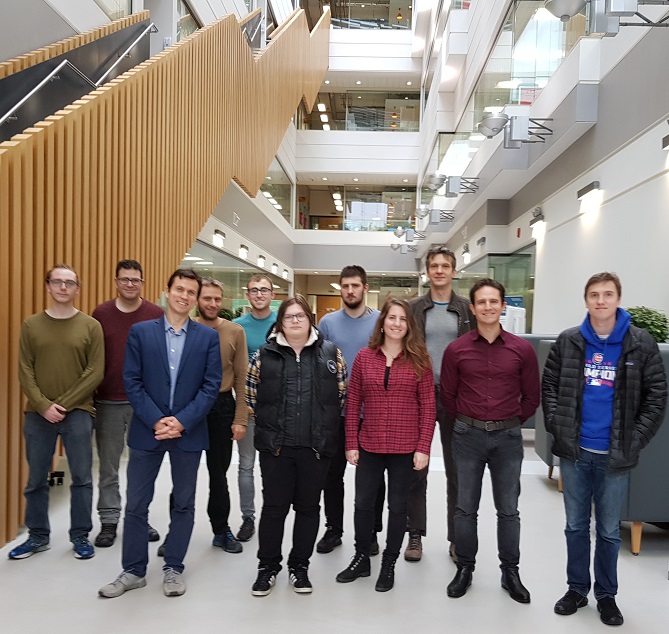
- 25 October 2019. Georg Osang (IST Austria). Periodic Delaunay triangulations.
- 18 October 2019. Marco Mosca. Delaunay triangulations and Voronoi diagrams.
- 11 October 2019. Thomas Welsch. Identification of organic compounds by a liquid crystal sensor.
- 4 October 2019. Vitaliy Kurlin. Isometric invariants of periodic point clouds.
- 27 September 2019. Phil Smith. Resolution-independent meshes of superpixels.
- 20 September 2019. Milo Torda. Dense periodic packings in the light of crystal structure prediction.
Back to All seminars | Back to Top of this page | Back to Home page
Group seminars in the academic year 2018-2019 (30 talks)
- 19 July 2019. Milo Torda. Crystallographic point groups and space groups from a group theoretic perspective.
- 10 July 2019. Phil Smith. An introduction to persistent homology (DMML seminar at 10 in Ashton 208).
- 5 July 2019. Milo Torda. Periodic packings in the light of crystal structure prediction.
- 28 June 2019. Cameron Hargreaves. Topological techniques for structural similarities in ionic compounds.
- 21 June 2019. Marco Mosca. Geometric invariants for clustering datasets of crystal structures.
- 14 June 2019. Krasen Samardzhiev. A change of a basis for linear maps in a matrix form.
- 7 June 2019. Katerina Vriza. Data-driven discovery of functional molecular co-crystals.
- 31 May 2019. Vitaliy Kurlin. Mathematical problems for infinite periodic structures.
- 24 May 2019. Yury Elkin. Links between persistence modules and hierarchical clustering.
- 3 May 2019. Cameron Hargreaves. Persistent homology for the filtration of alpha-complexes.
- 29 March 2019. Linear algebra exercises by Katerina, Marco, Thomas, Cameron, Krasen, Phil.
- 8 March 2019. Milo Torda. Algorithmic computation of homology groups for 2-dimensional complexes.
- 1 March 2019. Algorithmic computation of 1D homology by Katerina, Marco, Cameron, Thomas, Milo.
- 22 February 2019. Algorithmic computation of 0D homology by Katerina, Marco, Cameron, Thomas, Milo.
- 15 February 2019. Phil Smith. An introduction to homology groups with examples for graphs.
- 8 February 2019. Cameron Hargreaves. Persistent homology and its applications with the Ripser.
- 1 February 2019. Marco Mosca. Reduced cell theory and the instability of Niggli's reduced cell.
- 18 January 2019. Grzegorz Muszynski. Support Vector Machine and t-Distributed Stochastic Neighbor Embedding.
- 11 January 2019. Grzegorz Muszynski. Topological & Machine Learning Pattern Detection Methods in Climate Data.
- 14 December 2018. Phil Smith. Skeletonisation algorithms for unstructured point clouds with theoretical guarantees.
- 7 December 2018. Yury Elkin. Dual-tree algorithms and applications to data skeletonization.
- 30 November 2018. Fraser Holloway. A classification of pulse shapes from AGATA.
- 23 November 2018. Miloslav Torda. Optimal lattice packings in Euclidean spaces.
- 9 November 2018. Katerina Vriza. Symmetry groups of crystals in dimensions 2 and 3.
- 2 November 2018. Arshad Siddiqui. Polygonal vortex meshes in microscopic images.
- 26 October 2018. Cameron Hargreaves. Crystal lattices and notations for space groups.
- 19 October 2018. Thomas Welsch. Helping a robot to see a correctly placed piece of cloth.
- 12 October 2018. Krasen Samardzhiev. A Python-based tutorial on alpha-complexes.
- 5 October 2018. Krasen Samardzhiev. A Python-based tutorial on Delaunay triangulations.
- 28 September 2018. Marco Mosca. Voronoi diagrams and Delaunay triangulations.
Back to All seminars | Back to Top of this page | Back to Home page
Group seminars in the academic year 2017-2018 (25 talks)
- 14 June 2018. Krasen Samardzhiev. A Python-based tutorial on Topological Data Analysis.
- 31 May 2018. Grzegorz Muszynski. Diffusion maps for dimensionality reduction with examples.
- 24 May 2018. Grzegorz Muszynski. Periodic behaviour in low-dimensional representations of climate data.
- 10 May 2018. Krasen Samardzhiev. 1D persistent homology of census data in the US.
- 3 May 2018. Phil Smith. Reeb graphs and alpha-Reeb graphs for data skeletonisation.
- 26 April 2018. Phil Smith. Duality between persistent homology in dimensions 0 and 1 for 2D clouds.
- 12 April 2018. Krasen Samardzhiev. Persistent homology of alpha-complexes for 2D clouds.
- 22 March 2018. Krasen Samardzhiev. Homology groups: matrix computations.
- 15 March 2018. Krasen Samardzhiev. Homology groups: manual computations.
- 8 March 2018. Yury Elkin. Data skeletonisation algorithms for unorganised point clouds.
- The photo below was taken in February 2018. Members from left to right:
Naohiko Ban, Asim Munshi, Eris Tricker, Krasen Samardzhiev, Vitaliy Kurlin, Grzegorz Muszynski, Philip Smith.

- 22 February 2018. Naohiko Ban. Reconstruction of a vortex structure from 2D sequential images.
- 15 February 2018. Eris Tricker. Converting pixel-based skeletons into planar graphs.
- 8 February 2018. Asim Munshi. Thinning algorithms for black-and-white images.
- 25 January 2018. Grzegorz Muszynski. A topological detection of Atmospheric Rivers.
- 18 January 2018. Krasen Samardzhiev. Kuratowski's criterion for planar graphs.
- 11 January 2018. Yury Elkin. Straightening algorithms for polygonal curves.
- 20 December 2017. Yury Elkin. Skeletons of 3D clouds from micelles.
- 14 December 2017. Fraser Holloway. Pulse shapes from AGATA.
- 7 December 2017. Graham Briggs. Periodic crystal structures.
- 30 November 2017. Phil Smith. Simplest polygonal surfaces.
- 23 November 2017. Yury Elkin. The Euler characteristic.
- 16 November 2017. Krasen Samardzhiev. The union-find algorithm.
- 9 November 2017. Krasen Samardzhiev. Clustering algorithms for point clouds.
- 2 November 2017. Phil Smith. Topological equivalences of graphs.
- 17 October 2017. Phil Smith. Combinatorial graphs.
Back to All seminars | Back to Top of this page | Back to Home page
Links to useful resources for completing projects
- LaTeX Wikibook, LaTeX tutorials by Andrew Roberts.
- Graphics program: Inkscape available for free.
- Free tutorials on HTML by W3Schools.
- Free tutorials on Java by Oracle.
Back to Top of this page | Back to Home page
